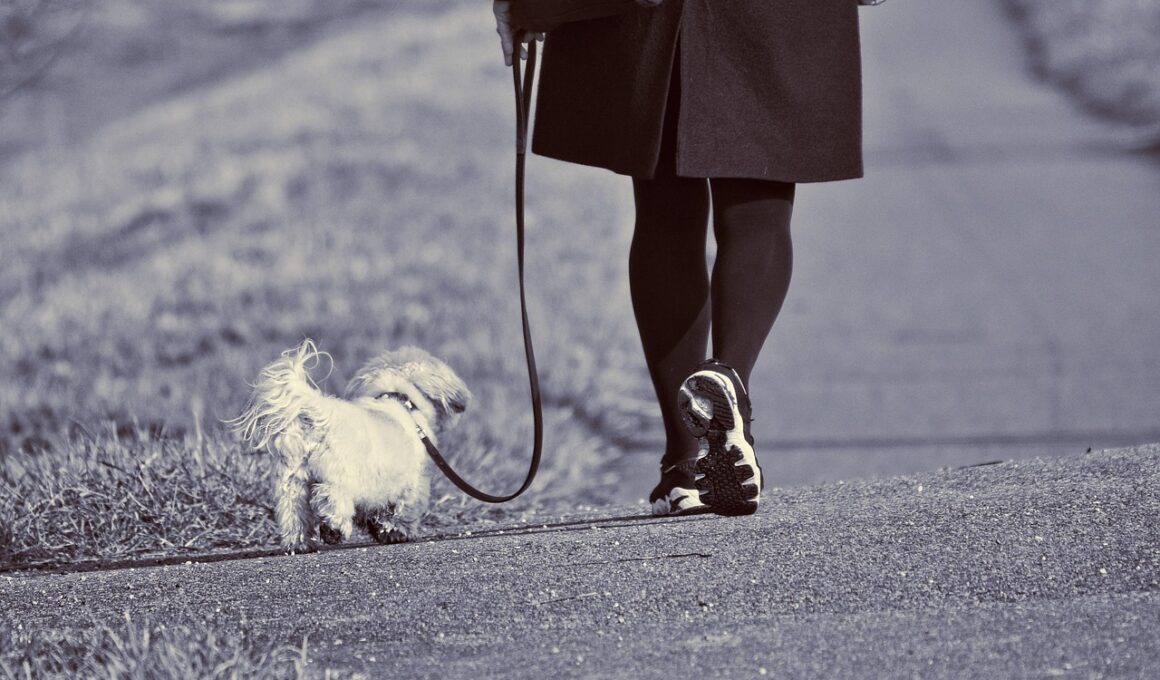Training Your Dog to Ignore Other Dogs on Leash Walks
Leash training is an essential skill that every dog owner should focus on, especially if your dog shows interest in other dogs during walks. Managing this behavior is vital for safety and enjoyment. First, understand that each dog is different; some are naturally more sociable while others remain aloof. You need to prepare with patience and consistent practice. Begin indoors, ensuring minimal distractions. Use treats to reinforce positive behavior when your dog ignores distractions. Once you establish some control indoors, gradually transition to outdoor settings with minimal distractions. Practicing structured leash manners gives them the foundation needed for this skill. Incorporate commands like “leave it” when encountering other dogs. This command teaches your dog to focus on you instead of any surrounding stimuli. A treat-reward system works wonders here. Consistency in your commands and expectation will help your dog to build good habits. Aim for short lesson durations to avoid overwhelming them. You can also consider a professional trainer if needed. Lastly, remember to celebrate progress, no matter how small it may seem. Positive reinforcement leads to confident, well-adjusted walking experiences later on.
Understanding Your Dog’s Behavior
Understanding your dog’s natural instincts is crucial in leash training. Dogs are inherently social animals that communicate through body language, scents, and sounds. When they approach other dogs, their behavior often stems from curiosity or a desire to engage. However, this behavior can lead to distractions during walks. Recognizing when your dog is becoming fixated on another dog is key. Look for tell-tale signs like pulling on the leash, raised tails, or eager barks. By understanding these signals, you can proactively redirect your dog’s attention. The goal is to create a focused mindset during walks. You can do this by utilizing high-value rewards to keep their attention on you when distractions are present. Associating other dogs with treats and praise can help associate their presence with positive outcomes. Gradual exposure to other dogs can familiarize your dog with their presence without causing anxiety. The next step is reinforcing this behavior as you encounter other dogs in public. The more your dog learns this skill, the easier future leash walks will be. Over time, your dog will feel reassured that ignoring other dogs while on a leash is their best option.
Pulling on the lead is a common issue dog owners face, especially when other dogs are nearby. This leads to stress not only for the dog but also for the owner. To manage this behavior, a few techniques are effective. Utilize proper leash placement; holding the leash a bit shorter will give you more control. When your dog starts to pull, halt your walking immediately. This teaches them that pulling will not lead to forward movement. Wait until there is slack in the leash before proceeding again. Reinforcing this with treats encourages them to stay closer to your side. The key is patience; dogs need time to understand this approach. Additionally, you may want to consider equipment designed for better control, like a no-pull harness. Just remember, consistency is everything. Also, think about choosing a safe space for practice, such as an empty park or yard. Slowly introduce challenges, increasing distractions as your dog’s confidence grows. Celebrate small victories and reward each accomplishment. Eventually, leash training will lead to much smoother walks, allowing you and your furry friend to enjoy exploration without constant tugging or stress.
Consistency in your training sessions is critical for success. Choose a specific spot to practice each time, which will help your dog connect that location with the expectations of behavior. Make sure to set realistic goals. Focus on very short training sessions – about 10 to 15 minutes is ideal. This time is perfect for keeping your dog’s attention while preventing boredom or frustration. Ensure each session ends on a positive note, to keep your dog motivated. Whenever possible, mix in playtime with rewards to maintain engagement. Incorporate frequent real-world practice sessions as well. These reinforce the behavior you want, showing mutually beneficial learning opportunities available in everyday walks. If your dog remains focused and ignores distractions, reward them with treats or a verbal cue that shows approval. Always be aware of your surrounding environment. Sudden movements, loud sounds, or other dogs can easily divert their attention. Address any initial distractions calmly and maintain focus during the training. Over time, you’ll find your dog becomes more adept at navigating challenging scenarios, remaining well-behaved on the leash during more stressful engagements and circumstances.
Maintaining Focus During Walks
Maintaining focus during walks can be challenging as dogs become excitable around new sights and sounds. To combat this, bring plenty of treats or favorite toys to pique their interest effectively. A well-timed treat can reinforce desired behavior. If your dog gets distracted by another dog, use that opportunity to redirect their attention on you instead. Call their name or use a command, followed by rewarding them as soon as they respond positively. Your enthusiasm during the leash training sessions is crucial; dogs often mirror their owner’s energy. Therefore, present a confident and engaging demeanor. Being calm yet assertive teaches your dog to trust your leadership. Use a verbal cue followed by a treat, as this reinforces the behavior you want. Consider walking routes that are less populated during your initial training to minimize distractions. Once your dog gains confidence ignoring other dogs, gradually introduce busier areas of your neighborhood. Regular practice in varying environments builds their skills and adaptability. Ultimately, practice will yield a dog that is well-mannered during casual strolls and can walk confidently, happy and focused by your side as they understand their role.
Socialization is a key factor in effective leash training. Socializing your dog not only helps them behave better around other dogs, but it also allows you to raise a more balanced and confident canine companion. Initiate socialization efforts as early as possible in their life, exposing them to various situations, people, and fellow dogs. Gradually introduce them to controlled doggy play sessions, where you can maintain supervision. This can ease anxieties around other dogs while they learn proper interactions. Positive encounters foster good behaviors and develop trust in their owners during walks. Also consider scheduling playdates with well-mannered dogs that don’t exhibit hyperactive behavior. This approach will provide a calm influence on your dog. Note that gradual exposure to various environments and different-sized dogs teaches healthy behavior patterns. However, never rush them into situations that overwhelm them. Understanding their pace and comfort for gradual exposure will be vital. By taking the time to socialize your dog, you contribute to their overall well-being as they learn the importance of being calm around other dogs, which is the ultimate aim of leash training.
Conclusion and Next Steps
In conclusion, training your dog to ignore other dogs during leash walks requires patience, consistency, and positive reinforcement. By understanding your dog’s instincts and behaviors and implementing effective training methods, you can make walks enjoyable for both of you. Remember to start in low-distraction areas and use high-value treats to encourage focus on you. Socialization and gradual exposure to other dogs are important for increasing confidence, building positive associations, and encouraging calm behavior. Incorporating commands like “leave it” will strengthen your dog’s ability to ignore distractions, too. Always maintain a calm and assertive demeanor during walks, reinforcing good behavior with rewards as appropriate. Note that this process may take time and varies from dog to dog. Some may master these techniques quickly, while others require several sessions to make progress. Celebrate every small success along the way, as these achievements reinforce your efforts. Enlist the support of a professional dog trainer if needed, as they can provide valuable insights and tailored guidance. With dedication, you will ultimately have a well-trained dog that walks confidently beside you, completely focused and calm.


